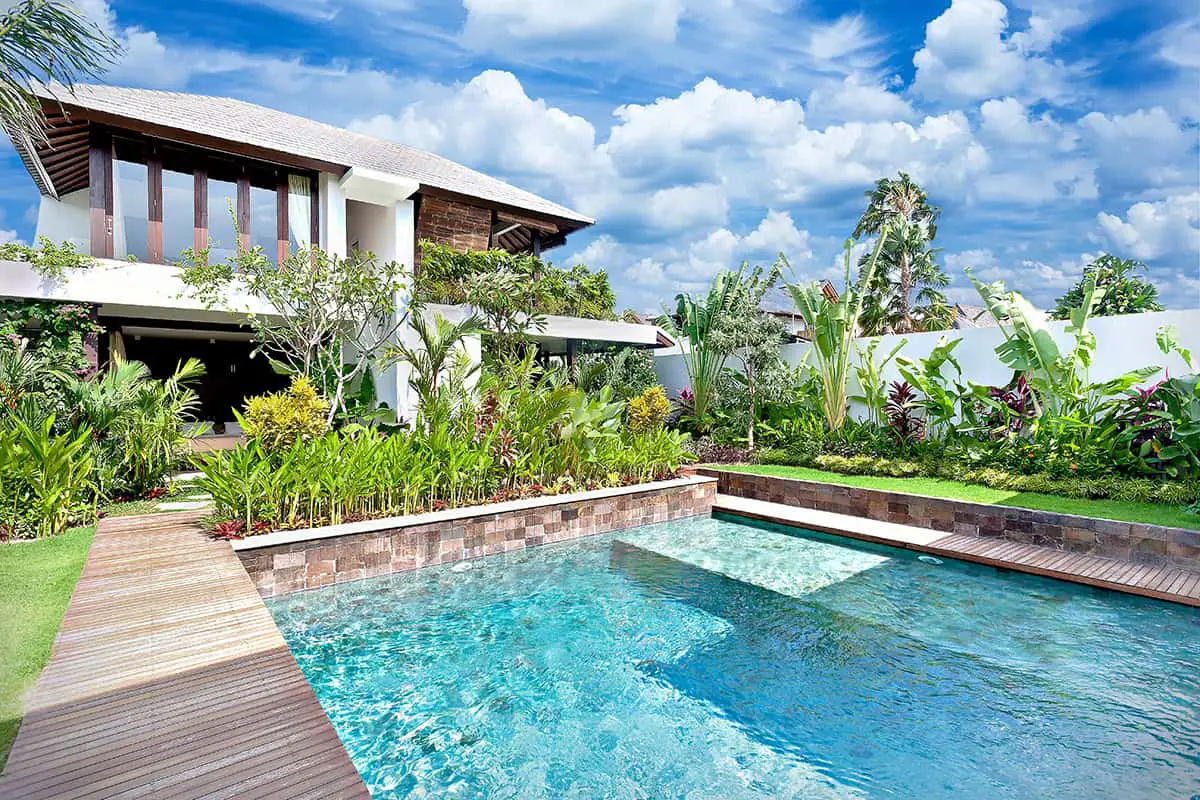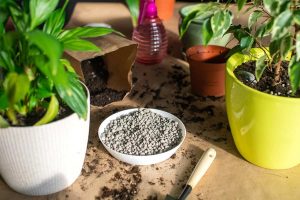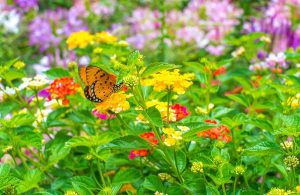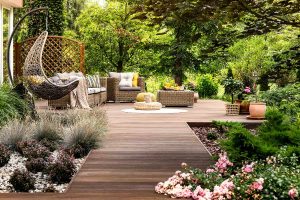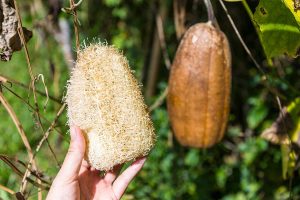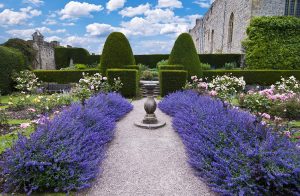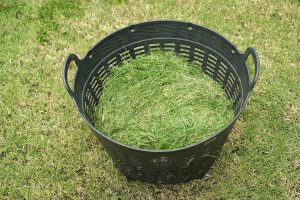You’ve just finished setting up your backyard pool, but something feels missing. The area around the pool looks bare and lacks the inviting, lush feel you envisioned. Adding the right plants can transform this space into a tropical oasis. Learn about the best plants to place around your pool to boost its beauty and create a resort-like ambiance.”
Table of Contents
Ornamental Grasses
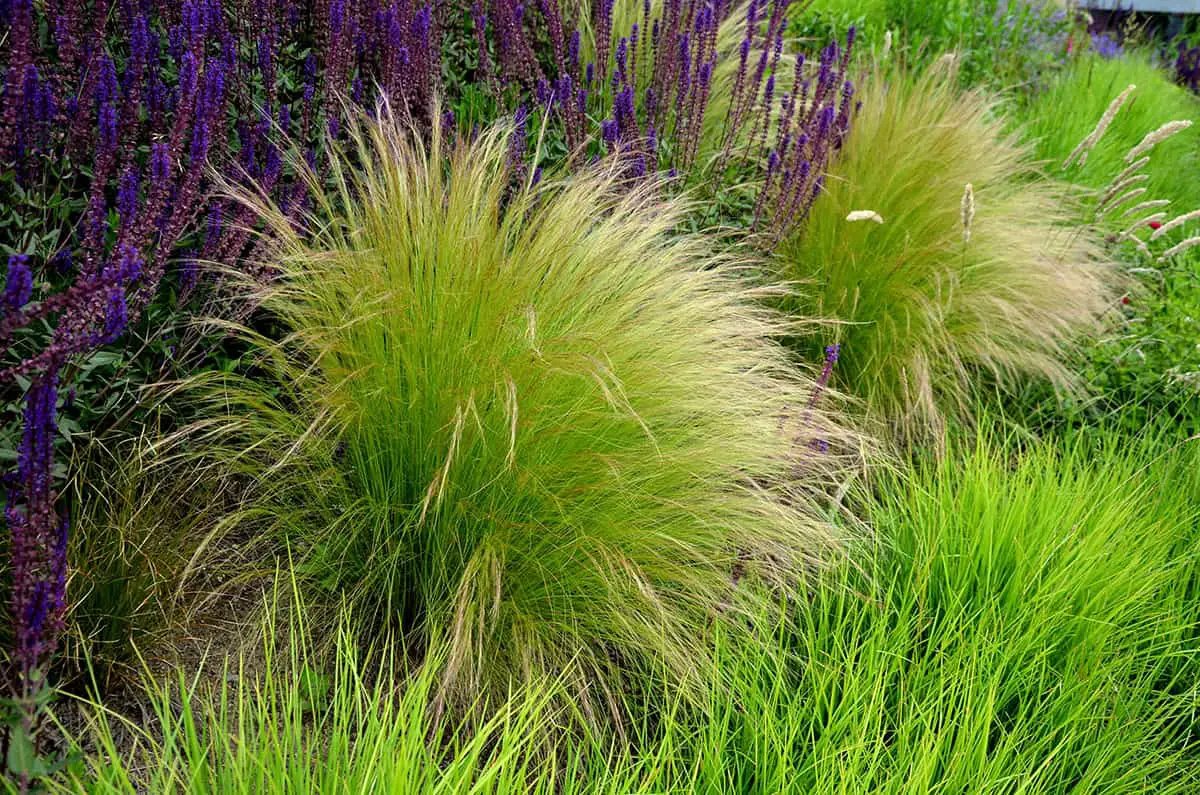
Selecting ornamental grasses for your poolside garden can enhance the ambiance with their soft textures and movement. These low-maintenance plants are ideal for creating a serene and inviting environment. They require minimal care, often needing less water.
You’ll find ornamental grasses thrive with just an inch of water weekly, allowing them to establish deep root systems. Consider installing drip irrigation to maximize water efficiency.
Your ornamental grasses need little fertilizer. A light application of a balanced fertilizer like 10-10-10 in late spring is enough to sustain them. Read more about the fertilization of these plants at the NC State Extension.
They generally demand full sun, requiring six to eight hours of sunlight daily. This ensures optimal growth and health.
Prune the grasses in early spring. Cut them back to about 6 inches to stimulate fresh, vibrant growth. This method also keeps your garden tidy and the plants healthy.
Incorporating ornamental grasses into your pool area not only adds beauty but also brings a sense of calm with their gentle sway in the breeze.
Bird of Paradise
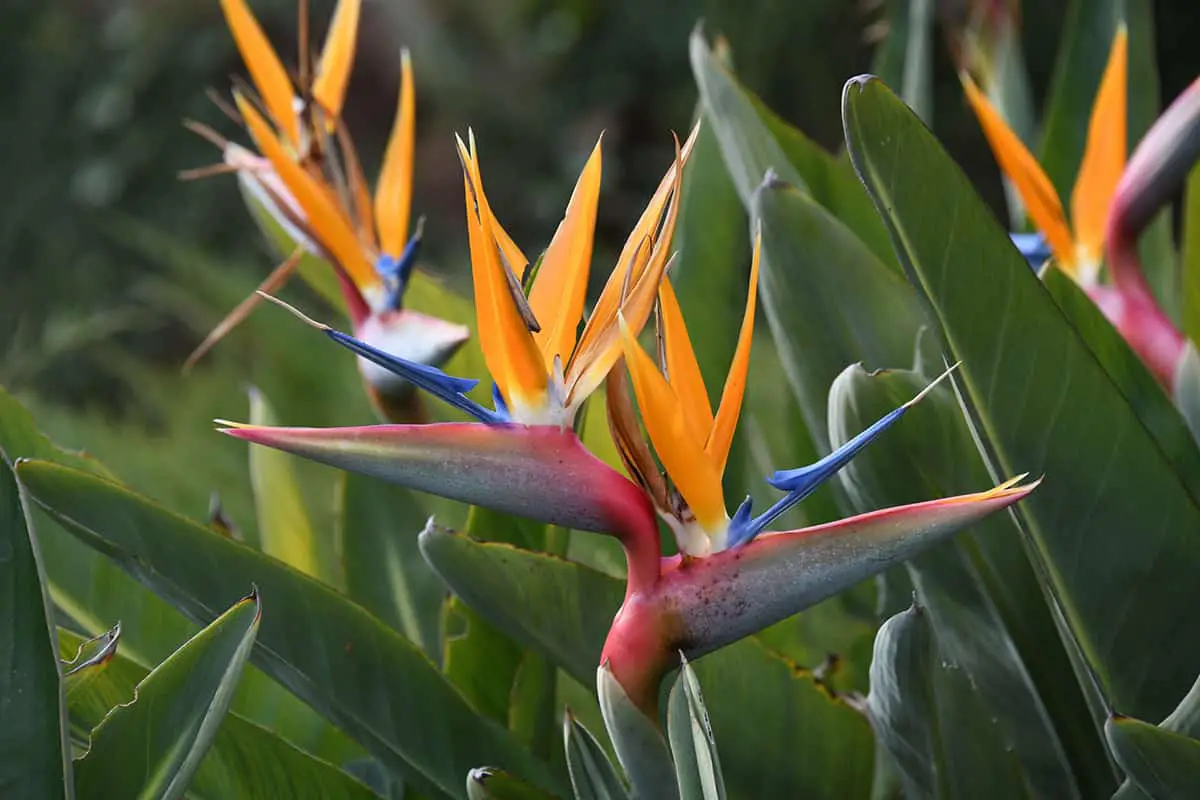
The Bird of Paradise is a striking plant, ideal for use around your pool area. Its vibrant flowers resemble a bird in flight, adding a tropical touch to landscapes. You can expect this plant to reach three to five feet in height, with a spread of two to four feet.
Leaves of the Bird of Paradise are oblong and stay a lush blue-green throughout the year. They extend 12 to 18 inches long on sturdy leafstalks. These plants form clumps and serve as natural focal points, bringing an exotic flair to pool settings.
Due to their evergreen nature, the leaves don’t drop frequently. This feature makes the Bird of Paradise perfect for poolside where falling foliage can be a concern. In Florida, they thrive across much of the state, although they may require cold protection in northern regions.
If you are aiming to elevate your outdoor pool space, consider incorporating the Bird of Paradise. It requires minimal maintenance once established and will turn your pool into an inviting tropical oasis. For more guidance, the University of Florida provides additional detailed insights on the care of this plant.
Palms
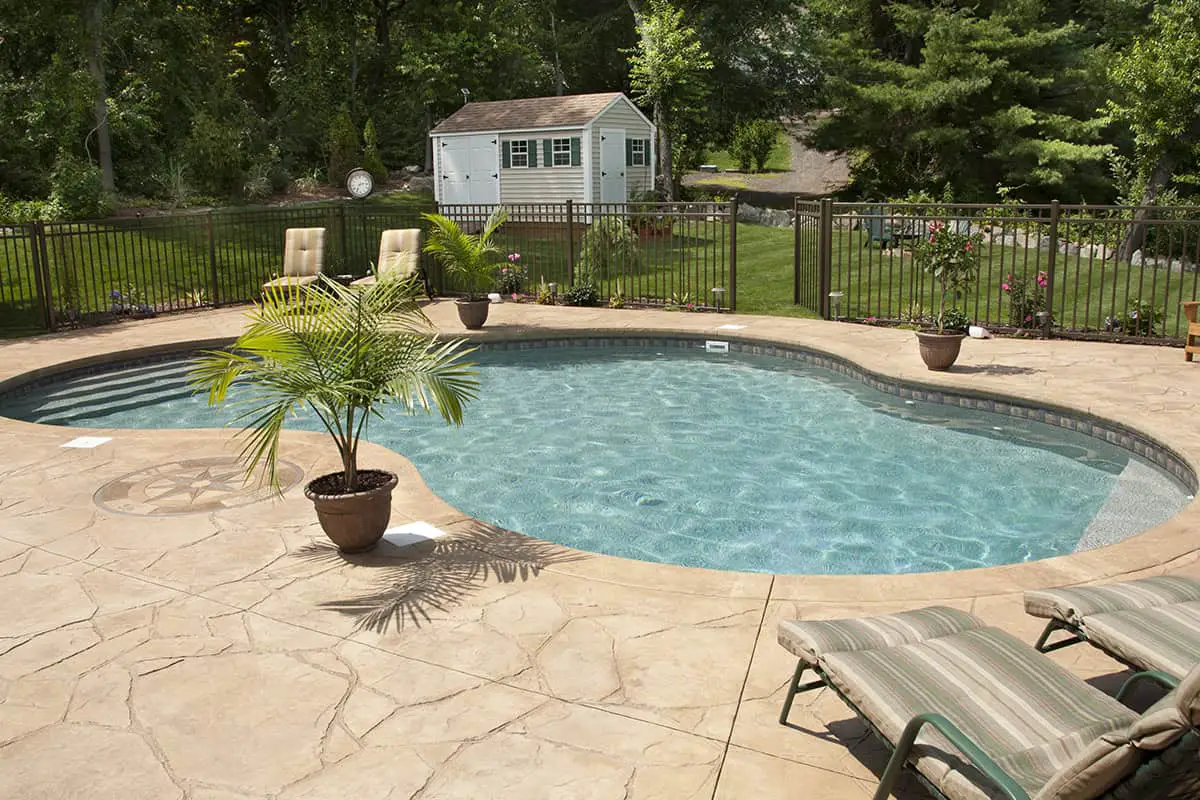
When selecting palms for your pool area, consider the space they require. Palms like the Areca can grow to be 25 feet tall and 10 feet wide. You need an area that can handle their size at maturity. They favor well-drained soil and can tolerate different light conditions, thriving in both full sun and partial shade.
European fan palms offer shade for your poolside. They’re clumping species that grow up to 15 feet tall. Thanks to their fan-like fronds, this palm adds a unique texture to your landscape. It’s also known for withstanding colder temperatures better than many of its counterparts.
For a tropical touch, palms are a fitting choice. They can provide privacy and enhance the surroundings. Ensure that planting is done in a location where their growth won’t interfere with pool structures. As with Palms & Cycads for the Midsouth Landscape, proper placement is crucial for the overall design and functionality of your pool area.
Agave
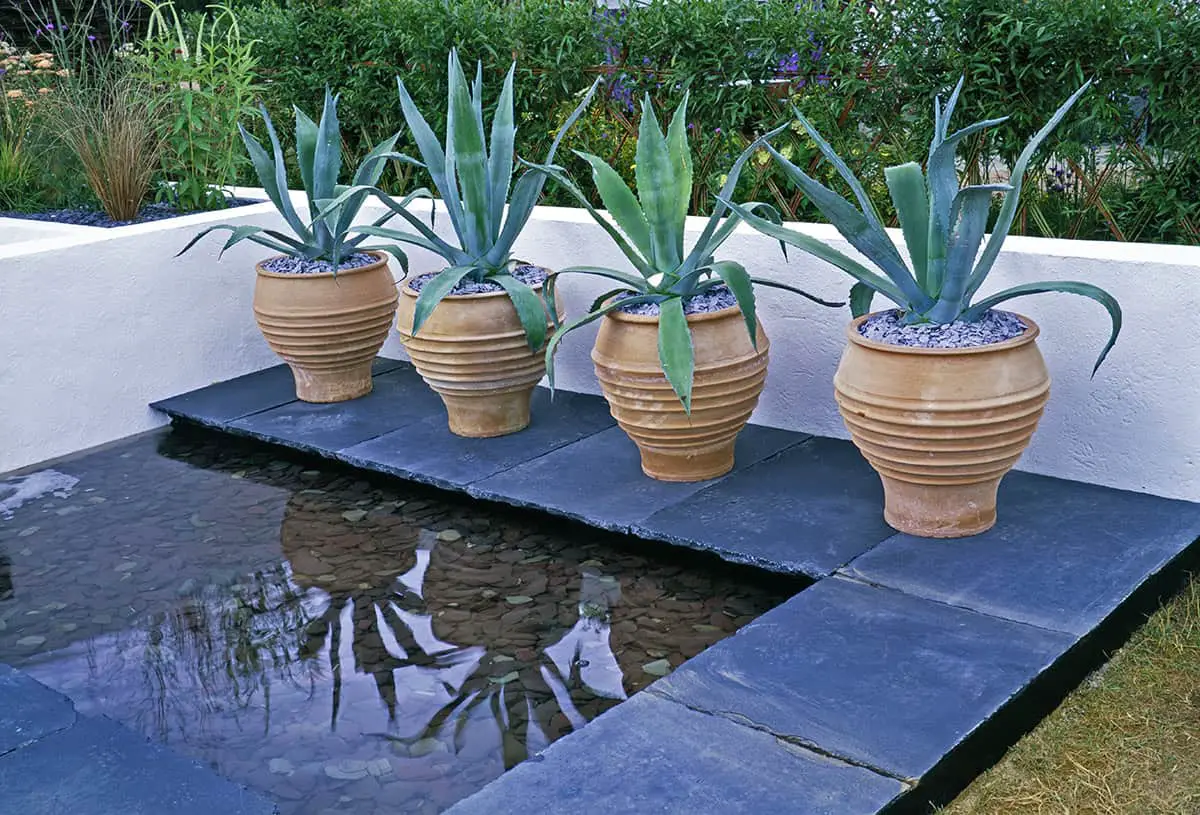
Agaves make striking additions to poolside landscapes. Your pool becomes more inviting with these plants. They frame your pool area with their architectural forms. The University of Arizona suggests they are ideal for creating a focal point.
These succulents offer a variety of shapes and sizes. Agave americana grows large and provides a dramatic effect. The University of California informs that this species can grow up to 12 feet wide. Their blue-gray leaves bring a cool hue to your garden.
Agaves need little water and maintenance. They tolerate heat and thrive in similar climates to Florida, as the UF/IFAS Extension suggests. You can count on these plants to withstand dry conditions.
Consider planting agaves for a durable, low-care garden element. They offer lasting structure through all seasons. The North Carolina Extension notes their resilience in various weather conditions. They won’t falter in rain or snow and keep their form splendidly.
Aloe
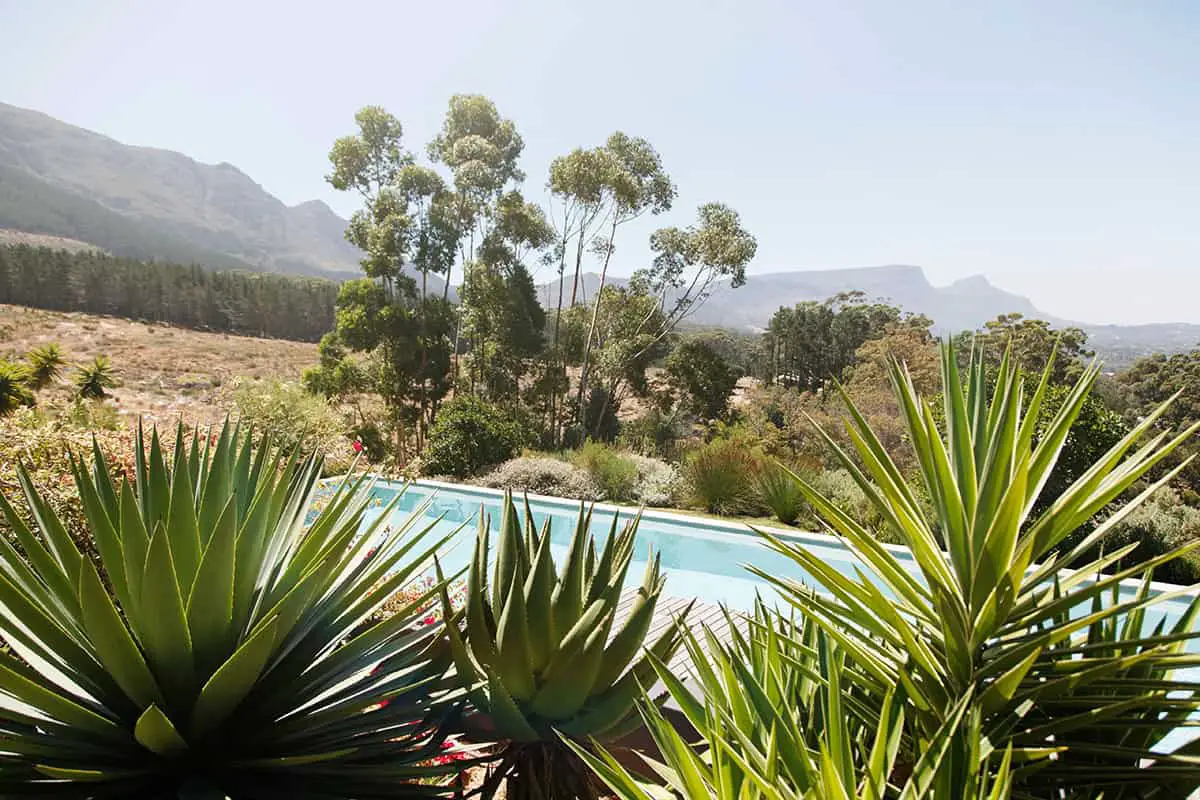
Aloe plants offer a stylish and practical choice for poolside landscaping. They are tough and can survive in hot, sunny areas. These succulents require little water, reducing the risk of water damage to your pool decking or equipment. Aloe is known for its medicinal properties, notably the soothing gel inside its leaves.
Position aloe plants in well-draining soil and ensure they receive plenty of sunlight. If you manage a container garden around your pool, aloe makes for an attractive, low-maintenance option. The plants have a striking appearance with fleshy, spiky leaves that add a modern touch.
When planning your poolside retreat, consider aloe vera not just for its beauty but for its practical benefits too.
Succulents
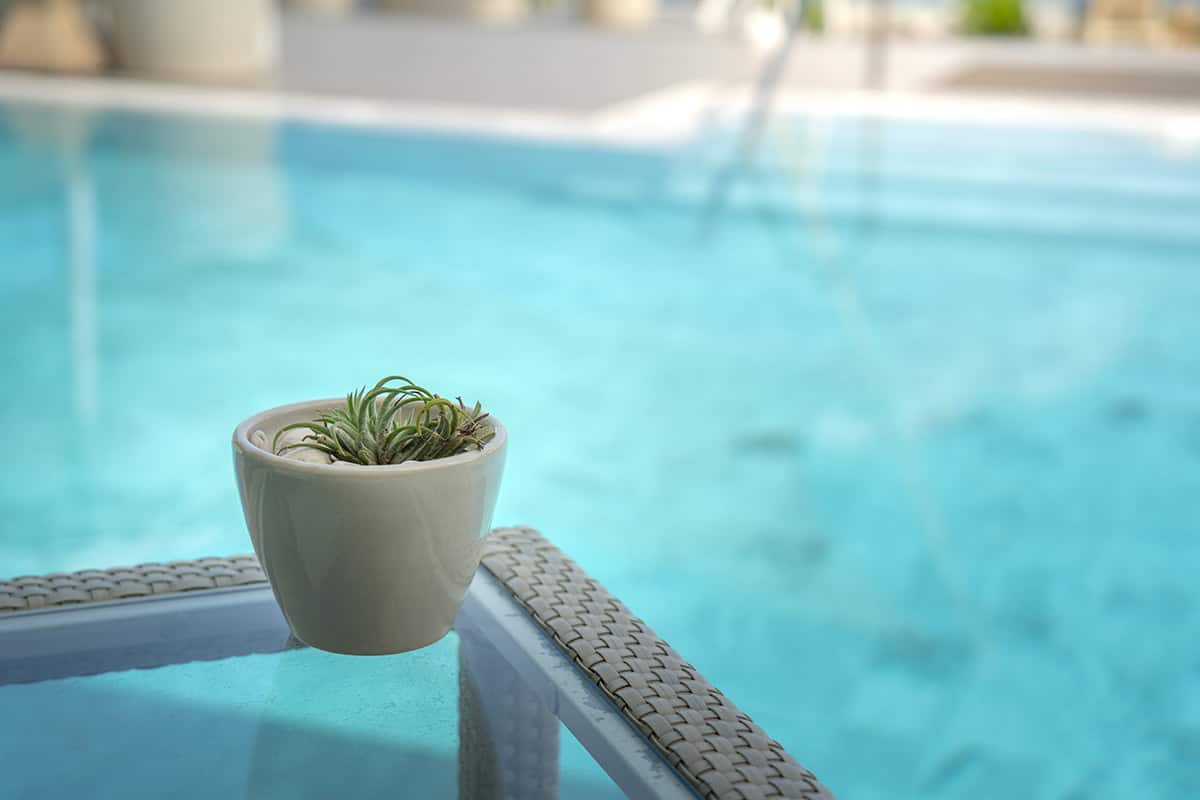
Succulents are an excellent option for your pool area. These plants require minimal maintenance and can thrive in the poolside’s sunny conditions. Succulents are well-known for their resistance to drought, which means they need less watering. This characteristic makes them suitable for environments where water conservation is a priority, like around a recreational area that already demands significant water usage.
Succulents also feature a variety of shapes, sizes, and colors. Your pool landscape can benefit from their versatility. You can select from options that stay small, so they don’t crowd your pool area. Alternatively, there are larger succulents that make bold statements. Remember to choose plants that will not drop leaves into the pool, ensuring easy maintenance.
A practical tip for growing succulents is to plant them during spring or fall. This timing allows them to establish themselves before extreme weather, whether it’s the summer heat or winter cold. These plants tend to be robust and can usually withstand the reflections and heat radiating from pool decks. Ensure that they are positioned well to enjoy the benefits of your pool’s microclimate. It’s crucial to have good drainage for your succulents as sitting in water can cause root rot.
Hibiscus

Hibiscus plants enhance poolside areas with vibrant blooms. These flowers offer a tropical touch that thrives in full sunlight. Hibiscus flowers require warm temperatures and rich, well-drained soil. You should prune them in late winter to promote bushy growth.
In less sunny spots, hibiscus still performs well but may produce fewer flowers. They can reach a considerable size, so plan your space accordingly. Hibiscus rosa-sinensis, for example, can act as a natural screen, offering both beauty and privacy.
To ensure your hibiscus flourish, water them regularly. They are not drought-tolerant and can show signs of stress if the soil dries out too much. Common issues include yellowing leaves and flower buds falling off. Keep an eye out for pests, as these plants can attract unwanted insects.
Choose varieties like ‘Southern Belle Mix’ for dramatic, large flowers that create a standout feature. These plants can grow up to four feet tall and have blooms over ten inches wide.
Bougainvillea

For a vibrant addition to your pool area, Bougainvillea is an excellent choice. You’ll appreciate its bright bracts that bring color and energy to any space. Its ability to thrive in hot, dry climates makes it well-suited for poolside landscaping.
Plant Bougainvillea in sandy or loamy acidic soil and ensure good drainage to prevent root rot. The location should receive full sun for the best growth and flower production.
Water Bougainvillea deeply but infrequently, allowing the soil to dry out between waterings. Feed with a fertilizer with a 1-2-1 ratio to support blooming, like a 10-20-10 blend.
Bougainvillea prospers in heat, can withstand drought conditions, and is salt-tolerant, making it ideal for pools near the ocean. However, be cautious with cold temperatures, as Bougainvillea is sensitive to frost.
To grow Bougainvillea around a pool, position it in a place where its thorns won’t be an issue for swimmers. A sturdy trellis supports its climbing nature, while a container allows for moving if needed.
Banana Plant
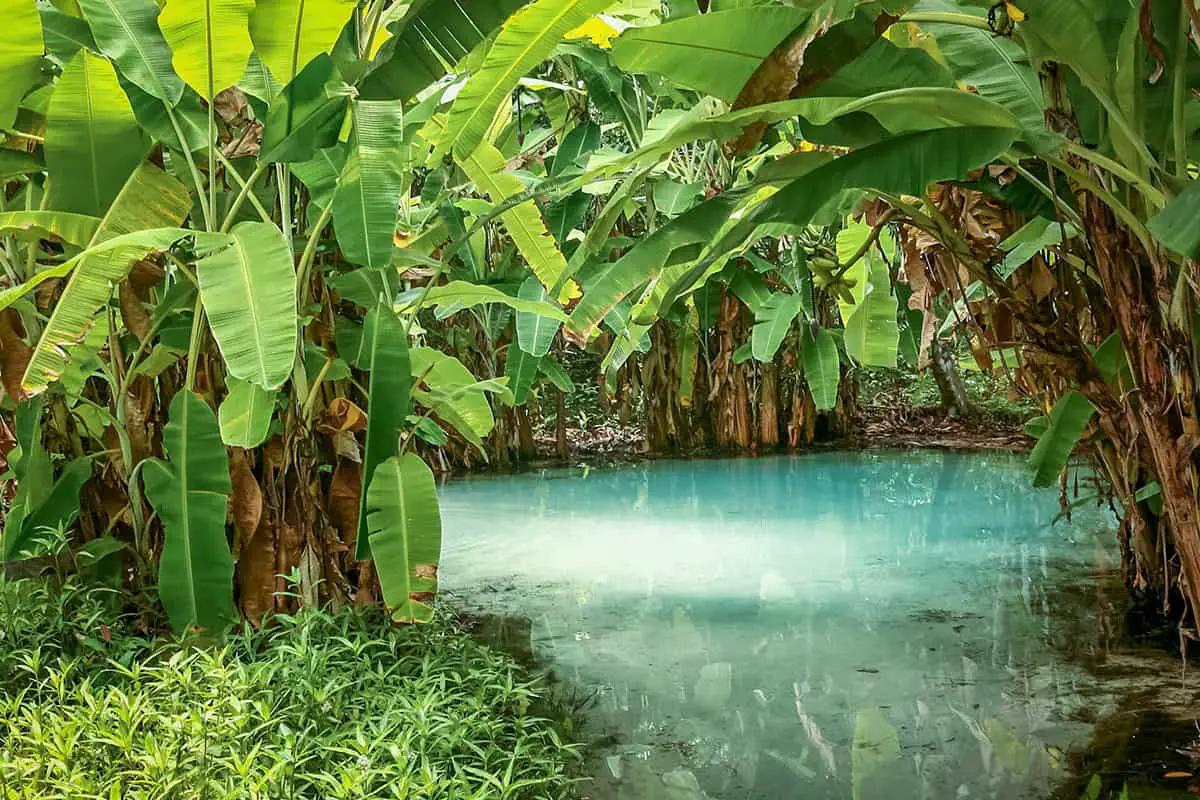
The banana plant can be the focal point of your poolside garden. Its broad leaves bring a tropical look to the area. You’ll enjoy a touch of the tropics right by your pool. Place banana plants in a spot with full sun for best growth.
Banana plants favor highly organic, moist soils. They thrive with proper nutrition, especially a specialized banana fertilizer. You should apply this to older trees seasonally. Young trees need fertilizing every two months in the first year. This ensures rapid leaf growth and healthy development.
Some banana plants are cold-hardy. For example, the Musa basjoo can survive cooler zones with heavy mulch. In spring, the plants will regrow even after the top dies back in winter.
For a lush poolside escape, banana plants are an excellent choice. They add height and a rich green hue to your landscaping. Their large leaves create a dense canopy of shade. This makes your pool area feel cooler on hot days.
Remember that banana plants can reach full size quickly. Usually, they grow a full set of leaves in just a few weeks. The swift growth is both a marvel and a testament to the plant’s ease of care.
Lantana

Lantana plants serve as a vibrant choice for your poolside area. With showy flowers and a tolerance to salt, they suit homes near the ocean. You’ll find their care straightforward and their water needs modest after establishment.
These plants can repel Aedes mosquitoes, renowned for spreading malaria, due to the oils they contain. They offer a dual benefit: beauty for your poolside and a reduction in pests. Opting for lantana means you’re selecting plants that attract butterflies, enhancing the liveliness of your space.
When you grow lantana, expect a shrub that can adapt to being cut back. This makes it easy to manage size and shape around your pool. They prefer warm soil and full sun to thrive, and in colder climates, it’s best to plant them when the frost has passed.
Lantanas come in a range of colors including yellow, orange, red, white, and purple. These flowers are not only eye-catching but also favored by hummingbirds and butterflies, contributing to a dynamic and attractive poolside ecosystem.
Jasmine

Jasmine plants create a captivating ambiance around your pool with their sweet fragrance and elegant appearance. These plants are best positioned at least 8 feet apart to ensure sufficient space for growth. With jasmine near your pool, you enjoy both the visual beauty and aromatic pleasure of these blooms. They thrive in well-lit areas but can also tolerate partial shade, providing versatility for different poolside locations.
Properly cared for, jasmine can remain relatively problem-free. In particular, common jasmine is known for its hardiness and minimal issues. For year-round interest, consider varieties like the winter jasmine, which is robust and can handle cooler temperatures.
When planting jasmine, the fall season is ideal, particularly for containerized plants. This timing allows them to establish roots before the growing season. Ensure regular watering and well-draining soil to keep your jasmine healthy.
Yucca
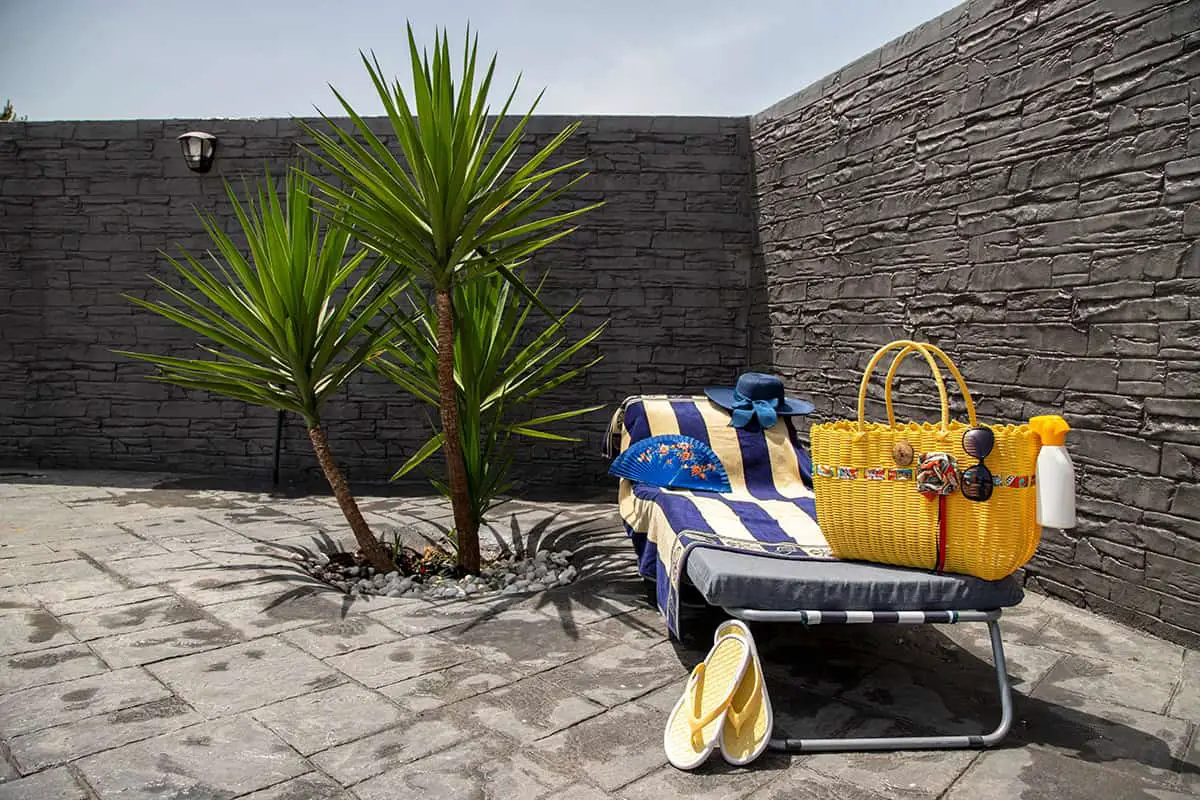
When considering plants for your poolside, yucca stands out as a robust option. This hardy perennial thrives in full sun, making it ideal for areas around swimming pools where sunlight reflects off the water. Yucca plants require minimal care, a benefit for busy homeowners. They are drought-tolerant, needing little water once established.
Yuccas offer an exotic touch with their sword-like leaves and towering flower spikes. These features provide an architectural element to poolside landscapes. For pool areas, selecting low-water-use plants like yuccas ensures that excess moisture doesn’t damage your pool decking or equipment. They typically don’t attract bothersome insects, keeping your pool area comfortable.
Various yucca species fit different space requirements. Some grow tall, with dramatic profiles, while others remain compact. Ensure you choose a species that aligns with your available space. The yuccas’ long leaves and showy flowers also serve as a visual barrier, offering privacy around the pool.
Daylilies
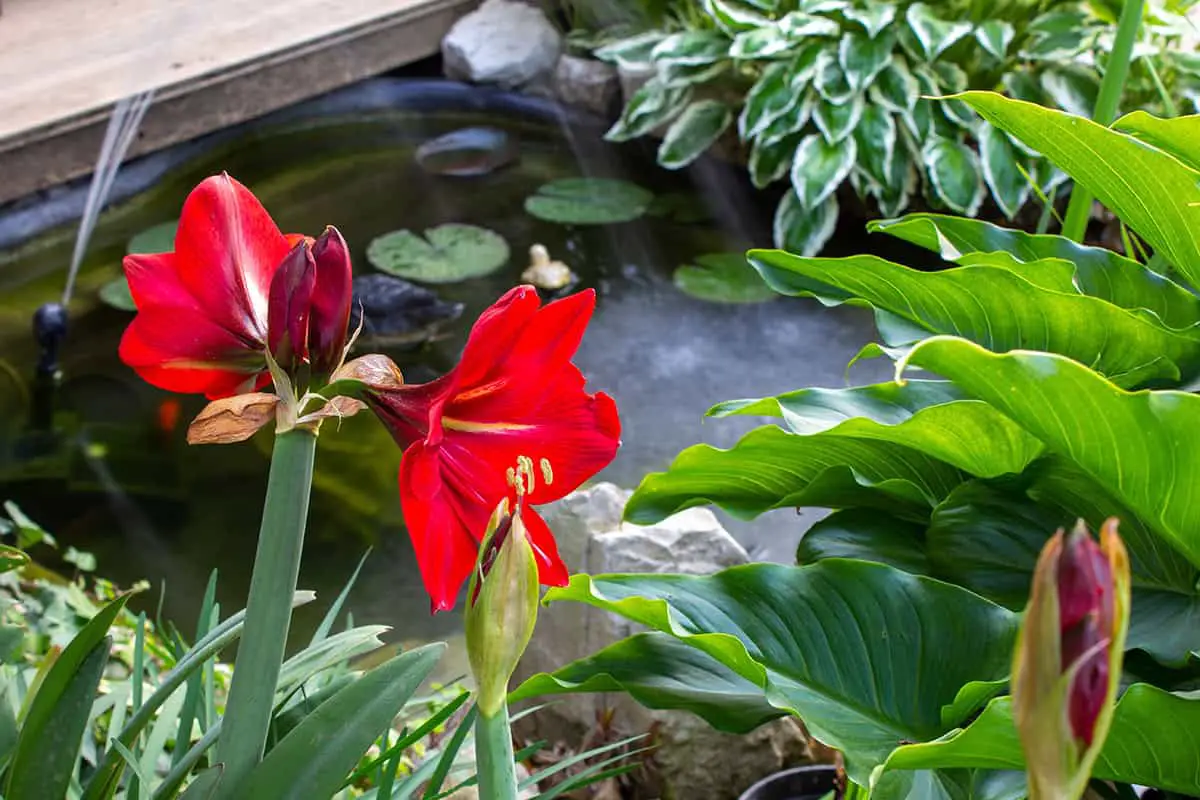
Daylilies offer a vibrant and sturdy option for your poolside garden. Their long, slender leaves and trumpet-shaped blooms bring color and texture. These plants are a popular choice for pool areas.
Hardy and easy to maintain, daylilies require minimal care. They thrive well even in the challenging conditions often found near pools. Their adaptability makes them a go-to for novice and experienced gardeners alike.
A variety of hues and blooming qualities are available. You can find a shade that complements any poolside design. They lend a classic touch with their long-blooming season. Daylilies can handle full sun, an advantage around open, sunny pool areas.
They need well-drained soil and moderate watering. This makes them suitable for planting near pools where overspray may occur. Daylilies resist pests and diseases, keeping your pool area looking pristine.
Choose from reblooming varieties. They continue to bloom through the season, offering continuous beauty.
Zinnias
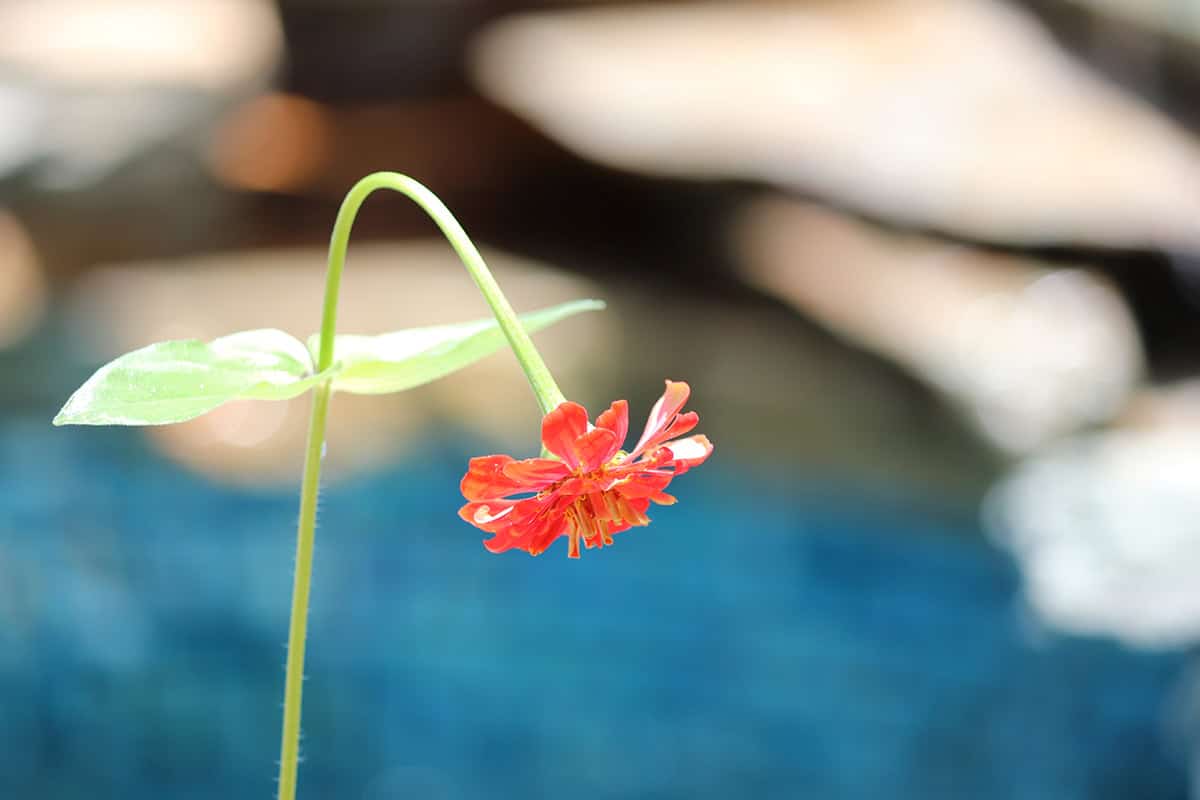
Zinnias enhance your pool area with vibrant colors. They thrive in full sun and tolerate heat. With their bright petals, zinnias are a cheerful choice for poolside beauty.
These flowers need well-drained soil to flourish. You’ll find zinnias bring life to your poolside with their varied hues. The plants can grow in containers or borders, adding versatility to your space.
Planting zinnias around your pool creates a pollinator-friendly zone. Butterflies and hummingbirds often visit these blooms. This makes your poolside both a relaxation and observation spot.
Care for zinnias involves regular watering and deadheading. This maintenance keeps the flowers blooming longer. Give each plant enough space to ensure good air circulation and prevent disease.
Marigolds

Marigolds are a top choice for your poolside garden. They thrive in full sun, needing at least six hours of direct sunlight daily. With their vibrant colors, marigolds add a cheerful touch. Plant them in well-draining soil for best growth.
Choosing marigolds for your pool area comes with benefits. They are low maintenance and can withstand the heat reflected by pool decks. This makes them both practical and attractive as poolside plants.
Varieties like French marigolds are compact, ideal for borders. French varieties grow to about 6 to 12 inches, fitting perfectly along walkways. African marigolds, on the other hand, are taller and make a statement with larger blooms.
To plant marigolds, select a sunny spot. Ensure your soil is prepared and space the plants properly. Be mindful of the mature size of the cultivar when spacing.
Lavender

Lavender plants are ideal for poolside gardens. They are hardy and add a splash of color with their violet blooms. Their fragrance can enhance the pool experience, creating a relaxing atmosphere. Lavender thrives in full sun and well-drained soil, conditions often found near pools.
You’ll find lavender to be low maintenance. It requires minimal watering once established, making it drought-resistant. This resilience is perfect for pool areas where water conservation is essential. The plant’s natural oils are known for their calming properties, adding to the tranquil environment around your pool.
Moreover, lavender is excellent for adding structure to your landscaping. It can grow into a neat, rounded shape with minimal pruning. The plants also attract pollinators like bees and butterflies, bringing life to your garden. However, their strong scent deters most pests, which helps keep the pool area more comfortable.
Planting lavender could be beneficial if you seek a sturdy, aromatic plant for your poolside retreat. It combines utility with beauty, offering both visual and sensory rewards. For optimal results, consider growing lavender in zones 5 through 7.
Elephant Ears
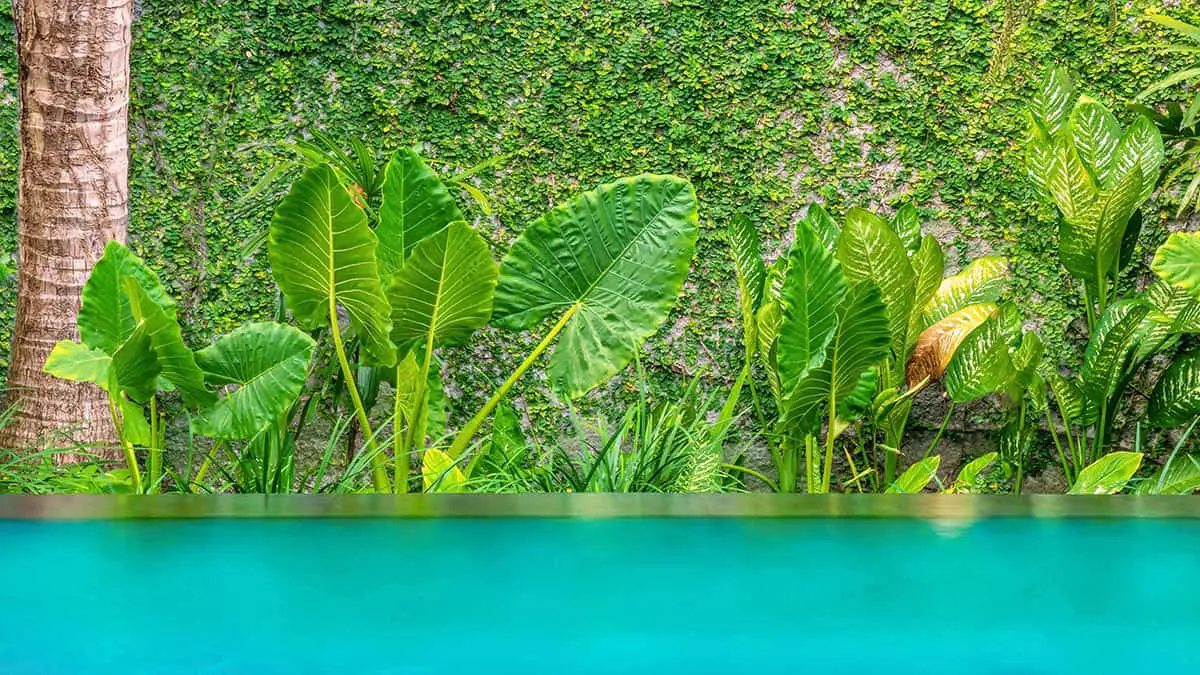
Elephant ears offer a lush backdrop for your pool area. These plants can grow large, heart-shaped leaves. Their size provides a tropical ambiance. Many types suit the poolside due to their love for moisture.
The Elephant Ear thrives in partial shade. Your pool often provides this with intermittent sunlight. Be wary of their needs for water. A dry spell might cause the leaves to droop. Ensure regular watering for healthy growth.
Selecting the right variety for your pool is key. The Colocasia is a common choice. They grow well with ample space to showcase their impressive leaves. Pair elephant ears with other foliage for a vibrant landscape.
Ferns

Ferns can thrive around your pool area, bringing lush greenery and a tranquil vibe. These plants prefer shade and can flourish even in areas with less sunlight. Select ferns that align with your pool’s watering schedule. Opt for varieties that won’t shed leaves into the pool, ensuring easy maintenance.
Look for ferns that fit well in the space available. Some, like sword ferns, can grow large, so they need more room. You’ll save time on upkeep with these simple choices. Ferns also pair nicely with other shade-loving plants to enhance the green tapestry around your pool.
The reflective surfaces around your pool magnify sunlight and heat. Yet, some ferns can tolerate these conditions with the right care. Make sure you choose ferns that can withstand the amplified light without drying out. This selection lets you enjoy a verdant poolside without constant worry.
Including ferns in your landscape creates an inviting oasis. Their soft fronds can offer a striking contrast to the hard lines of pool decking. Plant ferns at a suitable distance from the pool edge to prevent excess moisture damage to their fronds.
Canna
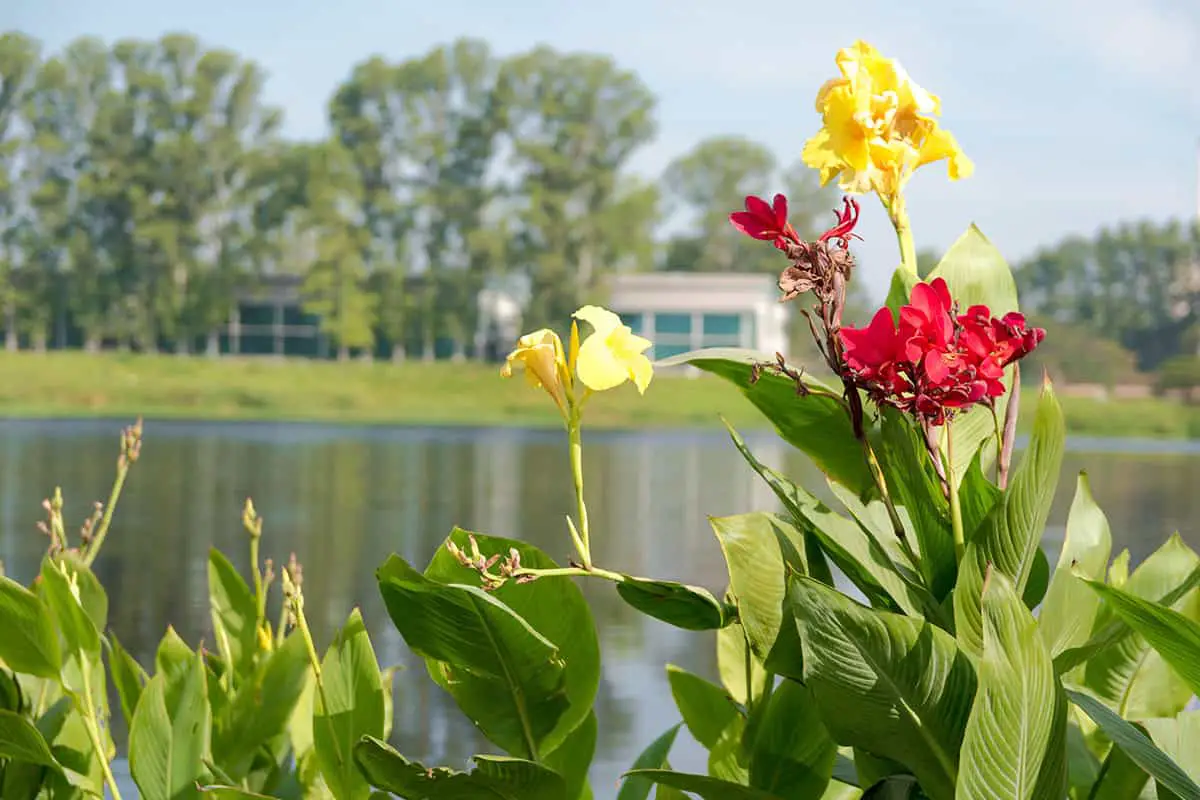
Canna plants are a striking choice for your poolside garden. They bring tall stems and vibrant blooms. With lush, tropical foliage, Cannas offer a splash of color that lasts all summer. As you consider these plants, remember they’re low maintenance and thrive in the pool’s microclimate.
Your pool area benefits from the Canna’s tall leaves, creating privacy. These plants can grow several feet high. The bold leaves of Cannas add architectural interest to your landscape. They come in green, bronze, or variegated patterns.
The flowers of Canna plants attract hummingbirds and butterflies. This adds life and color to your space. Cannas are available in red, orange, yellow, and pink hues. The blooms stand out against the water and stonework.
Consider planting Cannas in containers for easy rearrangement. They need full sun for optimal growth. These plants can handle the reflective light and heat near pools. Ensure the soil stays moist, as Cannas prefer wet conditions.
Place Cannas appropriately to revel in their grand stature and vivid blossoms. They provide an exotic look to your poolside retreat.
Dwarf Citrus Trees
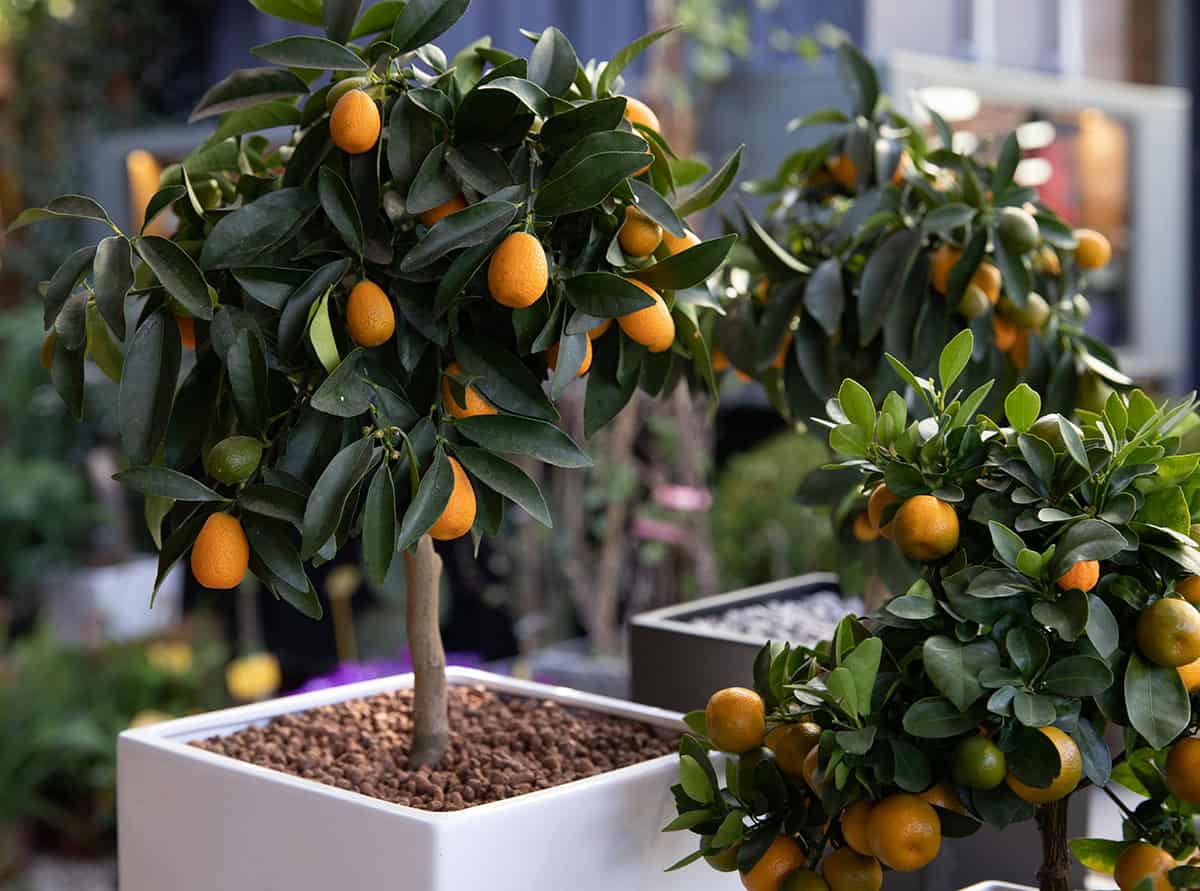
Dwarf citrus trees enhance your pool area with vibrant colors and refreshing scents. These trees stay small, ideal for limited space. You can enjoy full-sized fruits from these compact plants.
Selecting dwarf citrus trees requires understanding their needs. They thrive with adequate light and consistent moisture. Your efforts will pay off with their lush foliage and juicy produce.
If you’re growing these trees indoors, you must hand-pollinate them to ensure year-round fruit production. Also, provide them with the right fertilizer to meet their nutritional requirements.
Keep your trees in temperatures between 65-70 degrees Fahrenheit during the day. At night, a range of 55-60 degrees is optimal. This mirrors the natural environment where they flourish.
Remember that dwarf citrus trees are grafted onto a cold-hardy rootstock. This makes them resilient and easier to manage as houseplants. Their maintenance as 3-to-6-foot tall houseplants fit well around a poolside.
Protect them from frost, as citrus trees and fruits are frost-tender. If space is a concern, consider growing them as espaliers on a trellis or fence.
